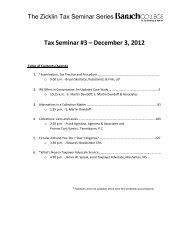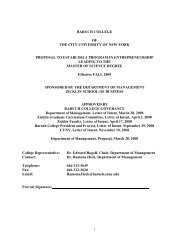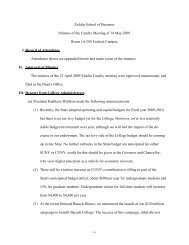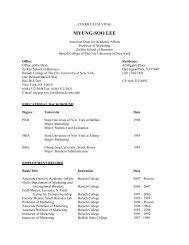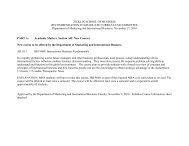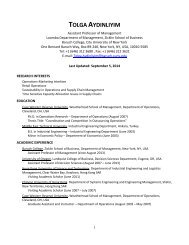Current Financial Reporting Trends
Current Financial Reporting Trends: - Zicklin School of Business
Current Financial Reporting Trends: - Zicklin School of Business
- No tags were found...
Create successful ePaper yourself
Turn your PDF publications into a flip-book with our unique Google optimized e-Paper software.
enumerated in your response dated August 19, 2005. On page 36, you state that the $573 million<br />
allowance generally represents loss carryforwards for which utilization is uncertain given the lack of<br />
sustained profitability and/or limited carryforward periods in certain countries. Further, it would<br />
appear that management`s analyses underlying the decisions to change the tax status of certain<br />
foreign subsidiaries are based, in part, on projected adverse future operating results. There is a<br />
concern that readers may not be able to reconcile management`s SFAS 109 critical accounting<br />
estimates with the assumptions supporting the statement on page 32 that you do not have any<br />
material assets whose recovery is at risk. Please provide clarifying disclosure in future filings that<br />
reconciles this apparent inconsistency.<br />
Response to Comment #653 – Form 10-K; SIC: 2531 Public Bldg & Related Furniture<br />
The Company will provide additional disclosures in future filings with the Commission to reconcile<br />
the apparent inconsistency noted above. It should be noted that the Company records its valuation<br />
allowance for each legal entity or consolidated group based on the tax rules applicable in the<br />
jurisdiction where the entity or group is domiciled and the criteria set forth in SFAS 109 that<br />
requires the Company to evaluate both positive and negative historical evidence as well as<br />
expected future events. In contrast, the Company reviews its long-lived assets for impairment in<br />
accordance with SFAS 144, which requires the Company to group assets and liabilities at the<br />
lowest level, for which identifiable cash flows are largely independent of the cash flows of other<br />
assets and liabilities, and evaluate the asset group against the sum of the undiscounted future<br />
cash flows. When reviewing long-lived assets for potential impairment, the Company’s analysis<br />
gives consideration to overall customer/platform cash flows, which may be across multiple plants,<br />
subsidiaries and geographies, as well as the redeployable nature of certain equipment among the<br />
Company’s automotive plants. These differences will be clarified in future filings with the<br />
Commission.<br />
Comment #566 – Form 10-K SIC: 2030 Canned, Frozen & Preserved Fruit, Veg & Food<br />
Specialties<br />
We note the decline in your effective tax rate for the three years presented and the impact of this<br />
trend on your income from continuing operations and related earnings per share. Describe if you<br />
reasonably expect this known trend to continue, and if so, how it will impact income from continuing<br />
operations and any known events that will cause a material change in this relationship, as required<br />
by Regulation S-K Item 303(a)(3)(ii).<br />
Response to Comment #566 – Form 10-K SIC: 2030 Canned, Frozen & Preserved Fruit, Veg<br />
& Food Specialties<br />
While we agree with the Staff’s observation regarding the decrease in our effective tax rate from<br />
36.1% in 2003 to 30.5% in 2005, we believe more than two years of data are necessary for<br />
appropriate analysis before we could comment on changes being representative of a trend. Over<br />
the past 5 years our effective tax rate has been primarily impacted from tax consequences of<br />
changes in tax laws, corporate restructurings and most recently from changes in the capital<br />
structure in certain foreign subsidiaries, foreign tax credits and the settlement of tax audits.<br />
At the time we prepared our Form 10-K for the year ended April 27, 2005, we anticipated, based on<br />
our budget for fiscal 2006, that the effective tax rate for fiscal year 2006 would be between 31.0%<br />
and 33.0% which is approximately the mid-point of the effective income tax rate for the past two<br />
years. While we continue to have a reasonable basis to believe that a downward movement in the<br />
effective tax rate will not continue, there could be events, such as further tax audit settlements, that<br />
could have a favorable impact on our effective tax rate. The timing of each settlement is not readily<br />
determinable. Likewise, other matters arising out of the normal course of business equally could<br />
have an adverse impact on our effective tax rate.<br />
In our quarterly reports on Form 10-Q for the first and second quarters of fiscal year 2006 (which<br />
ended July 27, 2005 and October 26, 2005, respectively) we have disclosed the estimated effective<br />
tax rate for fiscal year 2006. In future filings if we reasonably expect a known trend to continue and<br />
23



